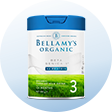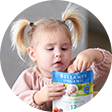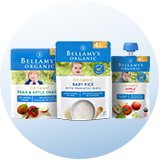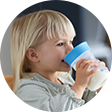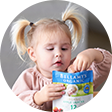Getting started on your child's gluten-free life
At present, the only treatment for coeliac disease is a lifelong gluten-free diet. The diet should commence immediately following confirmation of the diagnosis. It’s essential to learn how to get started, how to interpret a food label, and know which nutrients may be of more concern now the diet is gluten-free for life. It is recommended that you seek input from a dietitian with expertise in this area. If your child is still breastfed, there is no need to take gluten from your own diet. For a product to be called gluten-free in Australia, it must not contain oats, malt, or any ingredients derived from them. The final product must also have no detectable gluten. The minimum detectable level currently is <0.0003%. The current food standards require the manufacturer to label the ingredients that have been derived from a gluten-containing grain or indicate the presence of gluten ingredients in the product. Some ingredients from wheat are so refined they contain no detectable gluten and are allowed to be consumed. Your dietitian can help explain this. Coeliac Australia produces an Ingredient List Booklet with Phone App, which lists more than 800 ingredients and 300 additives used in Australia and indicates whether they are safe for inclusion in a gluten-free diet. This gives you instantaneous information about ingredients when out shopping. Tools like these can be a great help and the book is included in your start-up pack when you become a member of Coeliac Australia.
Managing a gluten-free diet
There’s no denying that managing a gluten-free diet can be challenging. It can be especially challenging for children, as they are continually surrounded by gluten on the playground, at daycare, at friend’s homes and at birthday parties. Your child will need to have a full understanding of why they are on a special diet, as you cannot be with them 24/7. At the very least, train your child to avoid obvious gluten in foods such as:
- Bagels/muffins/croissants
- Biscuits, crackers, cakes and other baked goods
- Bread
- Breakfast cereals
- Chicken nuggets
- Hamburger buns
- Pasta
- Pizza
There is a large range of gluten-free breakfast cereals on the market and even gluten-free bagels, muffins and croissants join the GF bread range that is now available. In modern times we have come to think of a snack as processed food from a packet. Let’s bring back grabbing a piece of fresh fruit or vegetable as a fast snack food. They are pre-packaged and ready to go! These contribute infinitely more nutrients to the diet than a processed packaged snack can. The quality of some GF snack foods is improving though as more food production companies move into the gluten-free market. Many packaged GF ‘bars’ on offer contain nuts, which can be tricky at most daycare centres and schools.
Try these easy gluten-free snack ideas:
- Cheese with rice crackers or GF seeded crackers
- Chicken drumsticks/GF falafel
- Cornthins/rice cakes/GF crackerbread range
- Dried Fruit and nuts
- Fruit kebabs
- Fruit smoothies
- GF nut and fruit bars/nuts
- Plain popped corn
- Quinoa GF microwave snack bowls
- Rice cakes with boiled egg, cheese, tomato or nut butter
- Rice crackers with avocado, hummus or GF dips
- Vegetable sticks with nut butter
- Yoghurt
Below are some suggestions for lunches or dinners. If you prepare a little more at night than you need, the extra meat or vegetables can be incorporated into lunch the next day.
- Corn tortillas and GF wraps with GF spread
- Fried rice with GF soy sauce
- GF Mexican chilli
- GF pasta with GF toppings
- Leftovers
- Meat/poultry/seafood/eggs/legumes with salad or vegetables
- Nacho’s
- Poké bowl style lunches with protein, quinoa, rice or buckwheat and vegetables
- Rice and Asian dishes with GF sauces
- Salads with GF crackers or bread
- Sandwiches made on GF bread (start by toasting them)
Gluten Contamination
Small, continuous background amounts of gluten from contamination can be enough to damage the intestinal lining, therefore it’s essential that care be taken in the kitchen to reduce cross-contamination with gluten. To help reduce the risk of gluten contamination:
- Replace staple pantry foods with gluten-free alternatives that the whole family can enjoy, such as GF soy sauce, GF stock cubes and GF flour, cornstarch
- Store gluten-free food in separate, clearly marked containers.
- For little children:- place well-sealed wheat products on higher shelves
- Use toastie bags when sharing a toaster.
- Line sandwich makers with baking paper before toasting your GF sandwich
- Use separate margarine and spreads to avoid contamination with regular bread crumbs.
- Drain gluten-free pasta first, or have a separate colander
- Thoroughly wash all chopping boards, pans, cutlery, saucepans, cake tins, storage containers and plates after use.
- Teach your family to read a gluten-free label
- Ask if a food is gluten-free when eating out, don’t try to guess the ingredients.
Recovery
Once your child is on a GF diet, the damage to their small bowel will start to heal. As they may have low levels of some vitamins and minerals at diagnosis, sometimes your doctor will suggest that your child have some extra supplements for a short while. If gut symptoms continue, they may also suggest a low lactose diet while your child’s bowel recovers. This is because the lactase enzyme sits on the end of villi that have been damaged. The loss of the enzyme from bowel damage means your child may not break down milk sugar very well until the villi recover, and the enzymes are restored. If you go lactose-free too, remember to try dairy products every few months to test when your child can again consume regular milk products. If left untreated and unmanaged, the long-term consequences of coeliac disease are related to chronic systemic inflammation, poor nutrition and malabsorption of nutrients. Complications ranging from iron deficiency to fertility issues in females to osteoporosis to gut-related cancers may develop. Coeliac disease is becoming better understood, awareness is growing and there are lots of food options available today to support gluten-free eating.
References
1. Brown AC. Gluten sensitivity: problems of an emerging condition separate from celiac disease. Expert Review of Gastroenterology & Hepatology, 2012;6(1), 43-55, DOI: 10.1586/egh.11.79
2. Husby S et al. AGA Clinical Practice Update on Diagnosis and Monitoring of Celiac Disease: Changing Utility of Serology and Histologic Measures: Expert Review. Gastroenterology. 2018 Dec 19. PubMed PMID: 30578783.
3. Comino I et al. Diversity in oat potential immunogenicity: basis for the selection of oat varieties with no toxicity in coeliac disease. Gut 2011;60:915-922
4. Hardy et al. Ingestion of oats and barley in patients with celiac disease mobilizes cross-reactive T cells activated by avenin peptides and immuno-dominant hordein peptides. J Autoimmunity, 2015;56:56-65
5. Anderson R et al. A novel serogenetic approach determines the community prevalence of Celiac Disease and informs improved diagnostic pathways. BMC medicine, 2013;11(1):188.
6. Green PHR and Jabri B. Celiac Disease. Annual Review of Medicine. 2006,Vol 57:207-221. https://doi.org/10.1146/annurev.med.57.051804.122404
7. Myléus et al. Early infections are associated with increased risk for celiac disease: an incident case-referent study. BMC Pediatrics 2012, 12:194 http://www.biomedcentral.com/1471-2431/12/194










